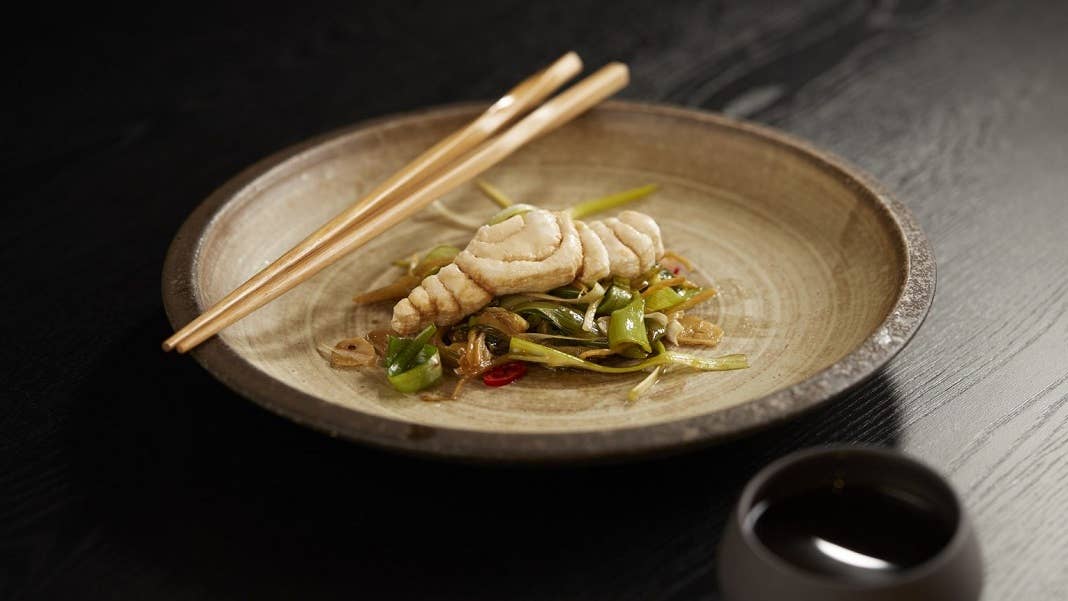This Real Fish Fillet Was 3D Printed From Cells Grown in a Lab

Share
Cultured meat is gaining momentum, with large production facilities under construction and the arduous approval process for the finished products inching forward. Most of the industry’s focus thus far has been on ground beef, chicken, pork, and steak. Save for one startup that was working on lab-grown salmon, fish have been largely left out of the fray.
But last month an Israeli company called Steakholder Foods announced it had 3D printed a ready-to-cook fish fillet using cells grown in a bioreactor. The company says the fish is the first of its kind in the world, and they’re aiming to commercialize the 3D bioprinter used to create it.
Steakholder Foods didn’t produce the fish cells it used to print the fillet. They partnered with Umami Meats, a Singapore-based company working on cultured seafood. Umami created the fish cells the same way companies like Believer Meats and Good Meat create lab-grown chicken or beef: they extract cells from a fish (in a process that doesn’t harm it) and mix those cells with a cocktail of nutrients to make them divide, multiply, and mature. They signal the cells to turn into muscle and fat, which they then harvest and form into a finished product.
Steakholder Foods takes the harvested cells and adds them to a “bio-ink” that also contains plant-based ingredients (this is mostly because of the plant ingredients’ cheaper cost, which brings down the final cost of the fish fillet). Layers of cells are put down one after the other, the fillet growing until it looks like the photo above. An added advantage of the 3D printing process is that it gives the fillet a flaky texture, just like real fish when it’s cooked well.
The type of fish used for this fillet was grouper, a “large-mouthed heavy-bodied” fish that tends to live in warm seas. Umami says its lab-grown grouper is healthier than the ocean-swimming version since it doesn’t contain any of the antibiotics, mercury, or microplastics that can unfortunately be found in wild and farmed fish.
Due to the resources it takes to raise animals like cattle and chickens and the emissions created by factory farming, eating meat has come to be seen by many as environmentally unfriendly. But farmed fish have their own set of problems; overfishing is depleting wild populations of all kinds of fish, including grouper, and warming waters are throwing off marine ecosystems’ natural balance and causing negative ripple effects throughout their food chains.
That said, is 3D printing fillets from a mix of fish and plant cells a viable solution? The cultured meat industry has come under fire due to the product’s high costs, scalability issues, and biological limitations, and fish is no different. Though raising whole animals to then slaughter them for just a few parts is obviously not ideal, it’s a system that’s been in place for decades; won’t it take decades to replace it, if replacing it is possible at all?
Umami CEO Mihir Pershad said, “We want consumers to choose based on how it tastes and what it can do for the world and the planetary environment. And we want to take cost off the table as consideration.” That’s a nice thought, but a bit unrealistic, especially in these times of high inflation and market uncertainty. It’s a small fraction of consumers that can afford to choose products based on their environmental impact; the rest choose based on cost.
Be Part of the Future
Sign up to receive top stories about groundbreaking technologies and visionary thinkers from SingularityHub.


Arik Kaufman, CEO of Steakholder Foods, is optimistic. “As time goes by, the complexity and level of these products will be higher, and the prices linked to producing them will decrease,” he said.
Umami has ironed out its production process for grouper and eel cells, and wants to add three more species to that list this year. The company hopes to bring its first products to market next year, starting in Singapore and then eventually the US and Japan.
Israeli Prime Minister Benjamin Netanyahu recently sampled the 3D printed grouper, making him the first prime minister to ever taste 3D-printed cultivated fish. Bet that’s not a badge he was expecting to earn during his government tenure.
Time will tell whether 3D-printed fish fillets can replace fish caught in water. But if companies like Steakholder Foods and Umami Meats succeed in making their vision a reality, people, animals, and the planet will all be better off for it.
Image Credit: Shlomi Arbiv/Steakholder Foods
Vanessa has been writing about science and technology for eight years and was senior editor at SingularityHub. She's interested in biotechnology and genetic engineering, the nitty-gritty of the renewable energy transition, the roles technology and science play in geopolitics and international development, and countless other topics.
Related Articles

This Week’s Awesome Tech Stories From Around the Web (Through December 13)

New Immune Treatment May Suppress HIV—No Daily Pills Required

How Scientists Are Growing Computers From Human Brain Cells—and Why They Want to Keep Doing It
What we’re reading